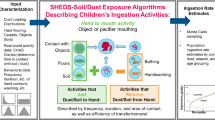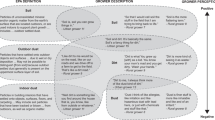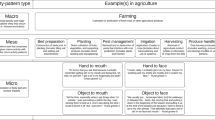Abstract
Ingestion of soil and dust is a pathway of children’s exposure to several environmental contaminants, including lead, pesticides, and fecal contamination. Empirically based estimates of central tendency for soil consumption by children in high-income countries range from 9 to 135 dry mg/day. Using a Monte Carlo simulation, we modeled the mass of soil directly and indirectly ingested per day by rural Bangladeshi children and identified the parameters that influence the mass ingested. We combined data from observations of direct and indirect ingestion among children with measurements of soil mass on the children’s hands, mother’s hands, and objects to quantify soil ingestion/day. Estimated geometric mean soil ingestion was 162 dry mg/day for children 3–5 months, 224 dry mg/day for children 6–11 months, 234 dry mg/day for children 12–23 months, 168 dry mg/day for children 24–35 months, and 178 dry mg/day for children 36–47 months old. Across all age groups, children placing their hands in their mouths accounted for 46–78% of total ingestion and mouthing objects contributed 8–12%. Direct ingestion of soil accounted for nearly 40% of soil ingested among children 6–23 months old. Sensitivity analyses identified that the parameters most affecting the estimates were the load of soil on the child’s hand, the frequency of hand-to-mouth contacts while not eating, and, for children 6–23 months old, the frequency of direct soil ingestion. In a rural, low-income setting, children’s soil consumption was substantially more than the estimates for children in high-income countries. Further characterizing soil ingestion of children in low-income contexts would improve assessments of the risks they face from soil-associated contaminants.
This is a preview of subscription content, access via your institution
Access options
Subscribe to this journal
Receive 6 print issues and online access
$259.00 per year
only $43.17 per issue
Buy this article
- Purchase on Springer Link
- Instant access to full article PDF
Prices may be subject to local taxes which are calculated during checkout



Similar content being viewed by others
References
Lanphear BP, Hornung R, Ho M, Howard CR, Eberly S, Knauf K. Environmental lead exposure during early childhood. J Pediatr. 2002;140:40–7.
Agency for Toxic Substance and Disease Registry. Toxicological profile for lead. Atlanta, Georgia: Agency for Toxic Substances and Disease Registry; 2007.
Simcox NJ, Fenske RA, Wolz SA, Lee I-C, Kalman DA. Pesticides in household dust and soil: exposure pathways for children of agricultural families. Environ Health Perspect. 1995;103:1126–34.
Agency for Toxic Substance and Disease Registry. Toxicological profile for DDT, DDE, and DDD. Atlanta, Georgia: Agency for Toxic Substances and Disease Registry; 2002.
George CM, Oldja L, Lee GO, Biswas S, Perin J, Lee GO, et al. Geophagy is associated with environmental enteropathy and stunting in children in rural Bangladesh. Am J Trop Med Hyg. 2015;92:1117–24.
U.S. Environmental Protection Agency. Soil screening guidance. Technical Background Document, Washington, DC; 1996.
Özkaynak H, Xue J, Zartarian VG, Glen G, Smith L. Modeled estimates of soil and dust ingestion rates for children: soil and dust ingestion. Risk Anal. 2011;31:592–608.
Mickle MH. Structure, use, and validation of the IEUBK model. Environ Health Perspect. 1998;106:1531–4.
Lepow ML, Bruckman L, Gillette M, Markowitz S, Robino R, Kapish J. Investigations into sources of lead in the environment of urban children. Environ Res. 1975;10:415–26.
Lepow ML, Markowitz S. Role of airborne lead in increased body burden of lead in Hartford children. Environ Health Perspect. 1974;7:99–102.
Day JP, Hart M, Robinson MS. Lead in urban street dust. Nature. 1975;253:343–5.
Duggan MJ, Williams S. Lead-in-dust in city streets. Sci Total Environ. 1977;7:91–7.
Wilson R, Jones-Otazo H, Petrovic S, Bonvalot Y, Williams D, Mark G, et al. Revisiting dust and soil ingestion rates based on hand-to-mouth transfer. Hum Ecol Risk Assess Int J. 2013;19:158–88.
U.S. Environmental Protection Agency. Update for chapter 5 of the exposure factors handbook. EPA/600/R-17/384F, Washington, DC; 2017.
Vuori V, Zaleski RT, Jantunen MJ. ExpoFacts—an overview of European exposure factors data. Risk Anal. 2006;26:831–43.
Moya J, Phillips L. A review of soil and dust ingestion studies for children. J Expo Sci Environ Epidemiol. 2014;24:545–54.
van Wijnen JH, Clausing P, Brunekreef B. Estimated soil ingestion by children. Environ Res. 1990;51:147–62.
Kwong LH, Ercumen A, Pickering AJ, Unicomb L, Davis J, Luby SP. Hand- and object-mouthing of rural Bangladeshi children 3–18 months old. Int J Environ Res Public Health. 2016;13:563.
Kwong LH, Ercumen A, Pickering AJ, Unicomb L, Davis J, Luby SP. Age-related changes to environmental exposure: variation in the frequency that young children place hands and objects in their mouths. J Expo Sci Environ Epidemiol. 2019. https://doi.org/10.1038/s41370-019-0115-8.
Geissler PW, Mwaniki DL, Thiong’o F, Friis H. Geophagy among school children in Western Kenya. Trop Med Int Health. 1997;2:624–30.
Ngure FM, Humphrey JH, Mbuya MNN, Majo F, Mutasa K, Govha M, et al. Formative research on hygiene behaviors and geophagy among infants and young children and implications of exposure to fecal bacteria. Am J Trop Med Hyg. 2013;89:709–16.
Luby SP, Rahman M, Arnold BF, Unicomb L, Ashraf S, Winch PJ, et al. Effects of water quality, sanitation, handwashing, and nutritional interventions on diarrhoea and child growth in rural Bangladesh: a cluster randomised controlled trial. Lancet Glob Health. 2018;6:e302–15.
Leckie JO, Naylor KA, Canales RA, Ferguson AC, Cabrera NL, Hurtado AL, et al. Quantifying children’s microlevel activity data from existing videotapes. Reference No. U2F112OT-RT-99-001182. Stanford University, Stanford, California; 2000.
U.S. Environmental Protection Agency. Guidance on selecting age groups for monitoring and assessing childhood exposures to environmental contaminants. Washington, DC; 2005.
Rodes CE, Newsome JR, Vanderpool RW, Antley JT, Lewis RG, Antley T, et al. Experimental methodologies and preliminary transfer factor data for estimation of dermal exposures to particles. J Expo Anal Environ Epidemiol. 2001;11:123–39.
Institute for Occupational Medicine. Inadvertent ingestion exposure in the workplace. Edinburgh, United Kingdom; 2007.
Brown LD, Cai TT, DasGupta A. Interval estimation for a binomial proportion. Stat Sci. 2001;16:101–17.
Chaudhari PR, Ahire DV, Ahire VD, Chkravarty M, Maity S. Soil bulk density as related to soil texture, organic matter content and available total nutrients of coimbatore soil. Inernational J Sci Res Publ. 2013;3:2250–3153.
Kissel JC, Shirai JH, Richter KY, Fenske RA. Empirical investigation of hand-to-mouth transfer of soil. Bull Environ Contam Toxicol. 1998;60:379–86.
Federal Insecticide Fungicide and Rodenticide Act Scientific Advisory Panel. A set of scientific issues being considered by the Environmental Protection Agency regarding: STOCHASTIC HUMAN EXPOSURE AND DOSE SIMULATION MODEL (SHEDS): System Operation Review of a Scenario Specific Model (SHEDS-Wood) to Estimate Children’s Exposure an. Arlington, VA; 2002.
Sahmel J, Hsu EI, Avens HJ, Beckett EM, Devlin KD. Estimation of hand-to-mouth transfer efficiency of lead. Ann Occup Hyg. 2015;59:210–20.
Galland BC, Taylor BJ, Elder DE, Herbison P. Normal sleep patterns in infants and children: a systematic review of observational studies. Sleep Med Rev. 2012;16:213–22.
Stanek EJ, Calabrese EJ, Xu B. Meta-analysis of mass-balance studies of soil ingestion in children: meta-analysis of soil ingestion. Risk Anal. 2012;32:433–47.
von Lindern I, Spalinger S, Stifelman ML, Stanek LW, Bartrem C. Estimating children’s soil/dust ingestion rates through retrospective analyses of blood lead biomonitoring from the bunker hill Superfund site in Idaho. Environ Health Perspect. 2016;124:1462–70.
Hogan K, Marcus A, Smith R, White P. Integrated exposure uptake biokinetic model for lead in children: empirical comparisons with epidemiologic data. Environ Health Perspect. 1998;106:1557–67.
Binder S, Sokal D. Estimating soil ingestion: the use of tracer elements in estimating the amount of soil ingested by young children. Arch Environ Health. 1986;41:341–5.
Bothe M. Quantifizierung der Ingestion von Boden durch Kinder. Germany: Dresden; 2004.
Clausing P, Brunekreef B, van Wijnen JH. A method for estimating soil ingestion by children. Int Arch Occup Environ Health. 1987;59:73–82.
Chien L-C, Tsou M-C, Hsi H-C, Beamer P, Bradham K, Hseu Z-Y, et al. Soil ingestion rates for children under 3 years old in Taiwan. J Expo Sci Environ Epidemiol. 2017;27:33–40.
Nchito M, Wenzel Geissler P, Mubila L, Friis H, Olsen A. Effects of iron and multimicronutrient supplementation on geophagy: a two-by-two factorial study among Zambian schoolchildren in Lusaka. Trans R Soc Trop Med Hyg. 2004;98:218–27.
Calabrese EJ, Stanek EJ, Pekow P, Barnes RM. Soil ingestion estimates for children residing on a superfund site. Ecotoxicol Environ Saf. 1997;36:258–68.
Wong MS. The role of environmental and host behavioural factors in determining exposure to infection with Ascaris lumbricoides and Trichuris trichura. University of the West Indies in Mona, Jamaica, 1988.
Calabrese EJ, Stanek EJ, Barnes R. Methodology to estimate the amount and particle size of soil ingested by children: implications for exposure assessment at waste sites. Regul Toxicol Pharm. 1996;24:264–8.
Zartarian VG, Xue J, Ozkaynak H, Dang W, Glen G, Smith L, et al. A probabilistic exposure assessment for children who contact CCA-treated playsets and decks using the Stochastic Human Exposure and Dose Simulation (SHEDS) model for the Wood Preservative Exposure Scenario. Presented at International Society of Exposure Analysis 14th Annual Conference, Philadelphia, PA; October 17−21,2005;2004.
Camann DE, Majumdar TK, Geno PW. Evaluation of saliva and artificial salivary fluids for removal of pesticide residues from human skin. San Antonio, TX: Southwest Research Institute; 2000.
Michaud J, Huntley S, Sherer R, Gray M, Paustenback D. PCB and dioxin re-entry criteria for building surfaces and air. J Expo Anal Environ Epidemiol. 1994;4:197–27.
Lin C, Wang B, Cui X, Xu D, Cheng H, Wang Q, et al. Estimates of Soil Ingestion in a Population of Chinese Children. Env Health Perspect. 2017;125:077002-1–8.
Halder AK, Tronchet C, Akhter S, Bhuiya A, Johnston R, Luby SP. Observed hand cleanliness and other measures of handwashing behavior in rural Bangladesh. BMC Public Health. 2010;10:545.
Cattaneo BMD, Galiani S, Gertler PJ, Martinez S, Titiunik R, Cattaneo MD, et al. Housing, health, and happiness. Am Econ J Econ Policy. 2009;1:75–105.
Acknowledgements
We gratefully acknowledge the WASH Benefits—Bangladesh study families who participated in the exposure assessment and provided environmental samples. This research was financially supported (in part) by grant OPPGD759 from the Bill & Melinda Gates Foundation to the University of California, Berkeley, and by a grant from the World Bank to the International Centre for Diarrhoeal Disease Research, Bangladesh. LHK was supported by the Stanford Wood’s Institute for the Environment Goldman Graduate Fellowship and the National Science Foundation Graduate Research Fellowship under Grant No. DGE-114747. Any opinion, findings, and conclusions or recommendations expressed in this material are those of the authors and do not necessarily reflect the views of the National Science Foundation.
Author information
Authors and Affiliations
Corresponding author
Ethics declarations
Competing interests
The authors declare that they have no conflict of interest.
Additional information
Publisher’s note Springer Nature remains neutral with regard to jurisdictional claims in published maps and institutional affiliations.
Supplementary Information
Rights and permissions
About this article
Cite this article
Kwong, L.H., Ercumen, A., Pickering, A.J. et al. Soil ingestion among young children in rural Bangladesh. J Expo Sci Environ Epidemiol 31, 82–93 (2021). https://doi.org/10.1038/s41370-019-0177-7
Received:
Revised:
Accepted:
Published:
Issue Date:
DOI: https://doi.org/10.1038/s41370-019-0177-7



